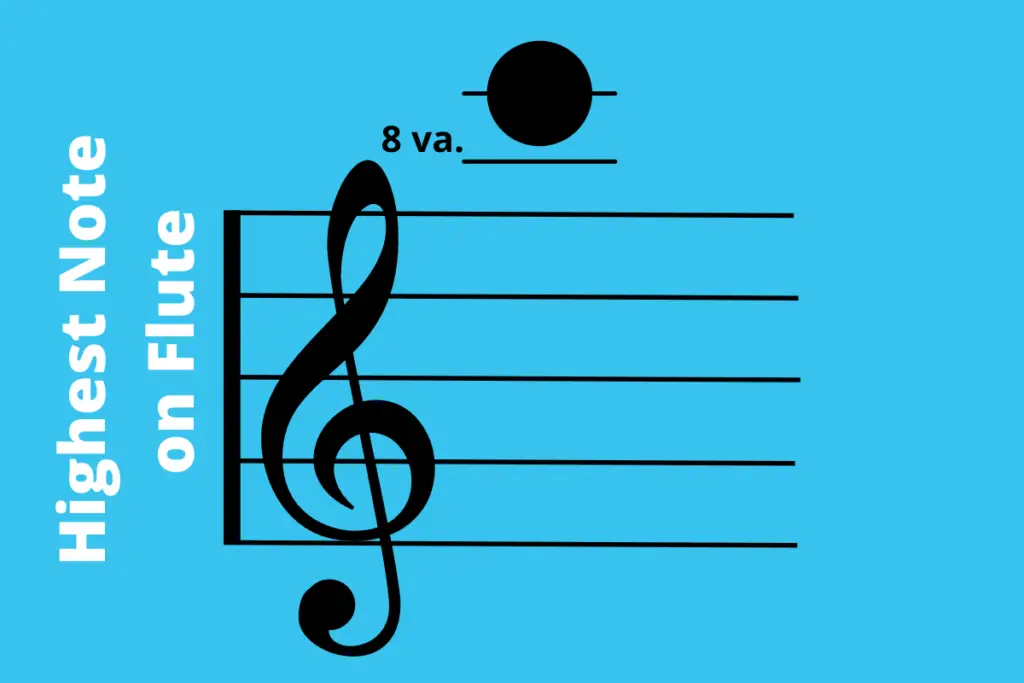When you’re writing for the flute or listening to it, you may wonder at its high range.
But do you know how high it can play?
I decided to do the research and come up with a thorough answer to the question, so you don’t need to wonder anymore.
The highest note on the Western concert flute is C7 or three octaves above middle C. This is what most people consider the highest practical note on the flute. Professional players may reach higher notes with special techniques up to F#7 or three octaves and an augmented fourth above middle C.
Let’s look at how this compares to other instruments, as well as tips for playing in this higher range.
Table of Contents
Highest Note On The Flute
As we talked about above, the highest note is generally is considered to be C7 or three octaves above middle C.
This is what most composers and arrangers use as the functional high note of the soprano flute.
Most beginners and intermediate players will struggle to hit this high note, but advanced and professional flute players will have little to no problem hitting it.
Part of the reason the flute plays this high is due to its length.
Check out how long a flute is.
The shorter the instrument, the higher it plays.
Still, the note C7 isn’t practical for a lot of playing.
At this point, many music composers opt for the piccolo, which has a naturally higher range.
Using alternate fingerings and altering the air column as it hits the lip plate across the embouchure hole, a professional flutist can reach even higher notes.
The highest for this level of play is considered F#7 and isn’t used in the vast majority of modern music.
Since the flute is a concert pitch instrument, what you see is what you play.
This note is so much higher than middle C, though; it’s often shown with the symbol “8va,” which means up one octave.
This makes it easier to read as you don’t need as many ledger lines.
Take a look at the common way it appears on the treble clef staff with the 8 va. in the image here.

Tips For Playing High Notes On Flute
Playing high notes on the flute requires some extra skill.
I’ll admit I’m not the best at this, so I talked to my flute friends, other band directors, and professional flute teachers and players to come up with this list of tips to help you out.
- Realize it takes practice
- Work your way up starting on a note you can play
- Long tone exercises work well for developing muscle memory
- Tighten the corners of your mouth more to get a more contracted shape
- Tilt the flute away from your mouth
- Adjust the aim of your air stream slightly against the back of the lip plate over the embouchure hole to find the sweet spot
- Think tighter, denser air
- Close your eyes and focus on the sound quality and the feel of your playing
- Tighten your embouchure slightly
This video may also give you some help:
Highest Notes For The Concert Flute Family
All flutes in the woodwind family have the same functional range of three octaves (the exception is the piccolo with one whole step less).
Take a look at this chart to see how they compare.
| Type Of Transverse Flutes | Lowest Note | Highest Note |
|---|---|---|
| Piccolo | D5 | C8 |
| Concert/Soprano/C/Standard flute | C4 | C7 |
| Alto flute | G3 | G6 |
| Bass flute | C3 | C6 |
| Contra-alto flute | G2 | G5 |
| Contrabass flute | C2 | C5 |
| Subcontrabass/ Double contrabass flute | C1 | C4 |
Remember, C4 is the middle C on the piano and in between the treble and bass clefs.
You may also want to read our guide to the range of the flute.
FAQ
What is the lowest note a flute can play?
The lowest note most soprano flutes can play is C4.
For some with a longer foot joint, it’s possible to bend the pitch down to B3, one half step below middle C.
This isn’t common and isn’t useful in playing, though it is possible.
Read more on the dedicated article about the lowest note on a flute.
Why does my flute sound fuzzy?
There are many reasons your flute may sound fuzzy, and only a few of them are related to the instrument itself.
The most common one is the fault of the player.
If your column of air is too wide, you’ll often have a whooshing sound coming from the tone quality of your instrument.
Tighten up your lips and focus your air more to create a better sound.
You may also be aiming too high or too low on the back plate. Either roll your flute or adjust where you’re aiming your air and see if this fixes the problem.
If this doesn’t work, it may be your flute.
Is the flute difficult to play?
The flute is hard to play at first as you get a handle on how to aim your air across the embouchure hole.
Once this is down, it’s a matter of memorizing flute fingerings and adjusting the space in your mouth to help guide the tone quality.
Overall, it’s a medium-difficulty musical instrument to learn.
But as with all wind instruments, to reach a professional level, you need to spend many thousands of hours playing and taking lessons.
The flute sheet music you’ll find in most band and orchestra music is a bit tougher on the flute than many of the other instruments, requiring a higher level of play from all flute players.
Can a flute play in any key?
A modern flute can play in any key. Though they are called C flutes or flutes in C, this doesn’t mean they only play this key.
The name of C flute comes from the fundamental pitch this woodwind instrument is based on, namely, C.
(This is why the standard range starts on C4.)
Why is my flute so flat?
As a general rule, a flute is flat either because of the player or the way it was put together by the player.
If the flutist uses a wide column of air, turned down lips, or has the flute tilted too much toward the player, it will sound flat.
However, you may have left the head joint out too far from the middle joint or body of the flute.
Read how to tune a flute for a detailed guide on tuning.

